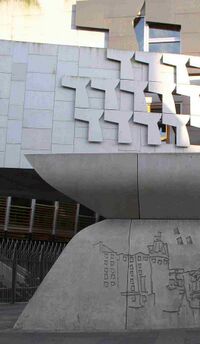Scottish Parliament
When the Scotland Act 1998 was passed by the UK Parliament, it led to the establishment of the first Scottish Parliament since 1707. The first members of the new Parliament were elected in 1999.
New Parliament Building
In 1999, the first Parliament met at the Assembly Hall at the top of The Mound, in the centre of Edinburgh. However, a new building was deemed necessary, and the chosen site was in Holyrood, opposite to the Royal Palace of Holyroodhouse but in an otherwise relatively depressed area of the city. The design for the new building was opened to competition, and the competition was won by a team led by Spanish architect Enric Miralles. Inspired by the surrounding landscape, the flower paintings of Charles Rennie Mackintosh and "upturned boats on the seashore", Miralles developed a design that he said was a building "growing out of the land"[1]. Over the course of the project, costs escalated from an initial estimate of £40 million to a final cost of over £420 million, an increase that did not altogether escape comment. The building has won many architectural awards, and attracts strong opinions for and against ("Every day that passes reveals some new and unexpected detail of Miralles's posthumous masterpiece. Here, an extraordinary courtyard, there, a wall with windows like you have never seen before. It is hard to make sense of such an original design."[2]). The interior is generally thought well of, and viewed from above it is spectacular, but many dislike the exterior appearance from ground level. That appearance that is not markedly embellished by the concrete bollards and large concrete, blast-proof walls that were a late addition to parts of the building, prompted by fears of terrorist attacks.
- "There is hope in honest error; None in the icy perfections of the mere stylist"
- Charles Rennie Mackintosh (1868-1928), quoted on the wall of the New Parliament Building

